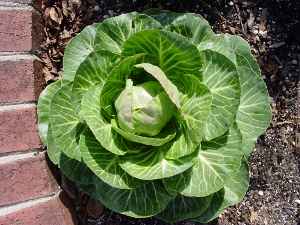Brassica oleracea (The Cabbage Family)
 Wednesday, August 27, 2014 at 1:50PM
Wednesday, August 27, 2014 at 1:50PM
It’s hard to believe that the peppy Chihuaha, huggable laboradoodle, and the massive Great Dane are all direct ancestors of the wolf, and while the differences might not be quite as striking, the same might be said for the kohlrabi, Brussels Sprout, and cabbage plants, which are all member of the same Brassica oleracea family.
These cultivars along with Kale, broccoli, collard greens, and cauliflower were selected by humans over thousands of years from the wild cabbage plant that can still be found growing in coastal areas of England, France and Spain. From there, cultivation and subsequent selections of wild cabbage spread into Europe, the middle east and Asia.
It was the Celts who cultivated cabbage varieties across Europe, and gave us many of the names we use today. Celtic words ‘kal’ or ‘kol’ evolved into the English ‘kale’ , and ‘kap’ became ‘cabbage’ and kappes in the German language.
Broccoli
Long considered an Italian cultivar, broccoli may have in fact first been developed in Crete and Cyprus. Whatever the origin, the cultivar had been dubbed the “Italian Asparagus’ by the 19th Century, and the flower buds were continuously selected for flavor and density. The broccoli plant is purported to have been introduced to the United States by the family of noted James Bond film producer, Albert R. Broccoli.
Brussels Sprouts
First noted in Belgium in the mid 18th century, later appearing in England and France at the beginning of the 18th century, the Brussels sprout plant was selected for its tight forming lateral leaf buds.
Cabbage
Selected for the tight drum heads that they form, red and white cabbage varieties originated in Germany, while the more cold tolerant, crinkly, Savoy cabbage varieties are thought to have been cultivated in northern Italy.

Kale
The closest relative of the wild sea cabbage, kale is notably both cold and heat resistant, and was selected for abundant production of nutrient packed leaves.
Cauliflower
Like broccoli, cauliflower was selected to form a dense head, and while most varieties are white, pink and purple cultivars have also been developed.
Kohlrabi
Developed for the large, round stem that forms at the base of the plant, the harvested kohlrabi is sometimes confused with a root vegetable.
Cultivation of Brassicas
While Brassica oleracea varieties may look different, genetically they’re so similar that cultivation is about the same for all of them. Though they famously thrive in cooler weather, kale and collard greens are also heat tolerant and when planted at the right time can survive both scorching summer heat as well as sub zero winter nights. Brassica family plants are heavy feeders, and will thrive in rich soil amended with plenty of organic compost and bone meal.
Leafy varieties like kale and collards should have a minimum of 12” between plants while heading types like broccoli and cabbage will appreciate a little more breathing room – somewhere in the neighborhood of 16”-18” between plants.
Crop rotation will help control insect pests like the cabbage worm which can cause a tremendous amount of damage to brassica varieties. Beware the flittering white moths flying among your brassica crop as they'll soon lay eggs that will hatch into hordes of hungry caterpillars and worms. Their cycle can be broken up with regular applications of neem oil spray, or Bacillus thuringiensis (B.t.) : a naturally occurring bacteria used as an organic pest control. ALWAYS follow the application instructions for any organic pest control product. Mixing neem oil spray stronger than the recommended rate, for example, can damage your plants.








Reader Comments